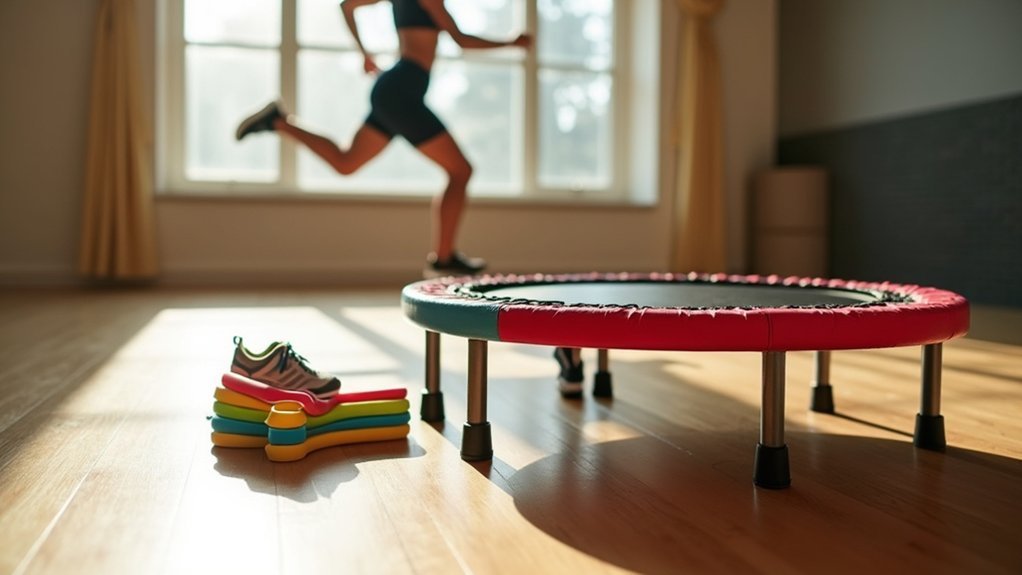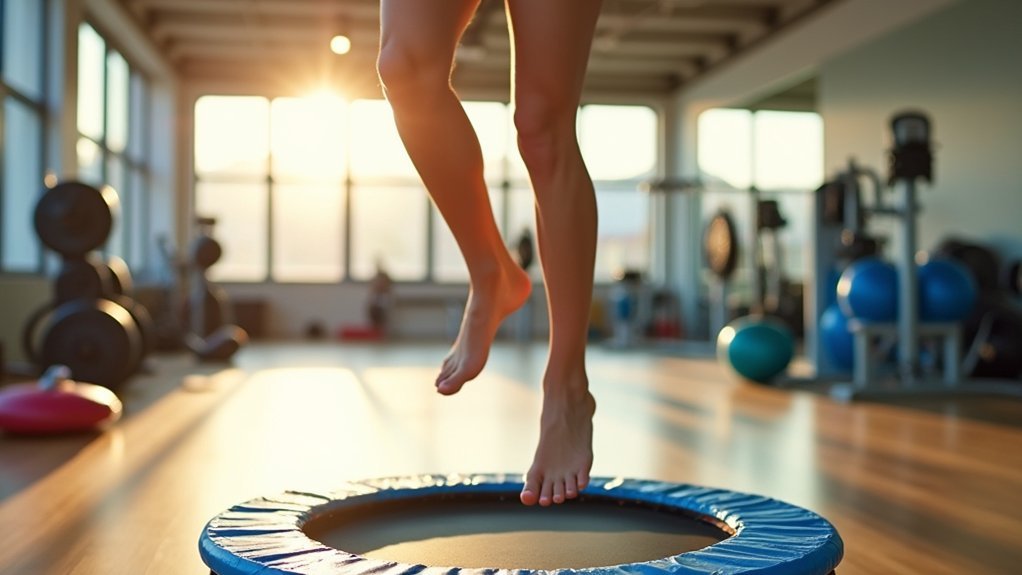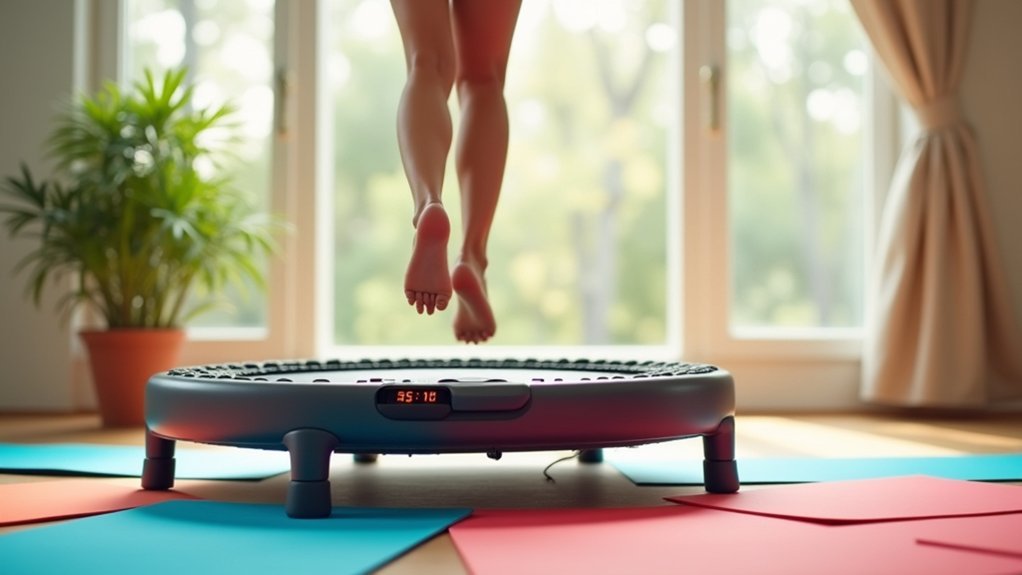Mini trampolines sculpt your body effectively with minimal impact. Start with basic bounces to engage quads, glutes and calves automatically while adding arm movements for upper body toning. Keep feet hip-width apart with bent knees, focusing on pressing through your heels to activate core muscles. Progress gradually from two-footed jumps to single-leg bounces for balance. Just 10-15 minutes three times weekly will transform your muscle definition and stability.
Getting Started With Mini Trampoline Muscle Sculpting

While traditional exercise equipment often isolates specific muscle groups, mini trampolines offer a unique full-body conditioning experience from your first bounce. Your lower body muscles—quadriceps, glutes, and calves—engage automatically with each controlled bounce, while your core activates to maintain balance.
Before starting, check your rebounder’s weight capacity (typically 250-300 lbs) and choose between spring or bungee systems—bungees provide quieter, smoother rebounds. The Jump Sport 350F with adjustable bungees offers excellent comfort for beginners and veterans alike.
Wear non-slip footwear or go barefoot depending on your comfort.
Begin with the health bounce, keeping feet close to the mat while focusing on control. Maintain a neutral spine and slightly bent knees to absorb impact.
Remember to breathe rhythmically—inhale on the upward motion, exhale on landing—while keeping your core engaged throughout.
Core Strengthening Bounce Techniques
Your mini-trampoline offers unique core-strengthening potential through specialized bouncing methods that engage deep abdominal muscles.
Try belly-lifting bounces by drawing your navel toward your spine while performing gentle rebounds, activating your transverse abdominis with each movement.
For heel-focused activation, concentrate on pressing through your heels rather than toes during bounces, naturally engaging your lower abdominals while maintaining proper alignment. Alternate between 40 seconds of active bouncing and 15 seconds rest to optimize muscle engagement while preventing fatigue.
Belly-Lifting Bounce Fundamentals
Three key principles form the foundation of effective belly-lifting bounces on a mini-trampoline.
First, maintain pelvic tilts by engaging your lower abs and tilting your pelvis upward during low rebounds, which specifically targets your abdominal muscles.
Next, focus on controlled microbounces while keeping an upright posture with slightly bent knees. This activates your deep core muscles throughout each bounce cycle.
For ideal results, incorporate transverse engagement by inhaling during leg movements and exhaling during lifts. This breathing pattern maximizes intra-abdominal pressure and intensifies core activation. Alternate knee lifts while bouncing to engage the core more effectively and incorporate ankle weights for increased resistance and intensity.
Add variety with hip-driven rotations that keep your shoulders square.
Try progressing to surf twists where you use rebound energy to power rotational movements, creating resistance that challenges your obliques and strengthens your entire core region.
Heel-Focused Core Activation
Activating your core through heel-focused movements on a mini-trampoline creates a uniquely effective workout experience. By pushing through your heels while bouncing, you’ll engage deeper core muscles as your body stabilizes on the unstable surface.
Try basic exercises like knee drives and kicks to strengthen your core while improving balance. Alternate between single-leg and two-leg bounces to enhance stability. For lateral core engagement, incorporate side-to-side movements.
Equipment matters—trampolines with elastic components like The Ness provide ideal bounce quality and reduced noise. Their arched design and buoyant mat offer both stability and comfort. The soft, responsive surface activates core muscles more effectively than traditional floor exercises while reducing stress on joints.
Always prioritize safety by keeping knees slightly bent and starting with gentle movements. Place your hands on your hips for extra stability if needed, and always adjust exercises based on your comfort level.
Lower Body Toning Rebounds for Beginners

Lower body toning rebounds form the foundation of effective mini-tramp workouts for beginners.
Start with your feet slightly wider than hip-width apart, knees softly bent, and core engaged by drawing your navel inward.
Focus on pressing downward into the rebounder rather than jumping upward to reduce impact. This action resembles stamping into mud while maintaining core engagement throughout the movement.
Practice front-to-back movements to activate your hamstrings, synchronizing your arms with each direction change.
For inner thigh toning, incorporate lateral movements with side-to-side hops. These provide lower impact alternatives to traditional jumping jacks while improving balance and coordination.
Once you’ve mastered bilateral exercises, progress to single-leg bounces to correct muscle imbalances and enhance ankle stability.
Remember to maintain proper knee alignment throughout, keeping them tracking behind your toes during all movements.
Upper Body Engagement During Trampoline Workouts
While bouncing on your mini-tramp, you’ll maximize results by incorporating arm pumping techniques that naturally enhance your cardio workout.
Torso twisting during rebounds engages your core, improves spinal mobility, and helps trim your waistline. Using light weights during your trampoline workout activates arm muscles while maintaining core stability, making your session more effective.
Try shoulder stabilizing movements like controlled arm circles to improve posture and strengthen upper body muscles without adding impact to your joints.
Arm Pumping Techniques
Upper body engagement transforms a basic mini-trampoline workout into a thorough exercise routine that targets multiple muscle groups simultaneously. Your arms aren’t just along for the ride—they’re essential for maximizing calorie burn and muscle toning.
As you bounce, incorporate isometric holds by extending your arms with fists or palms-up. This builds endurance while engaging your deltoids. Maintaining strong muscle tension throughout your movements creates resistance similar to using weights, making the workout more effective.
Practice “staggered punches” by alternating forward arm extensions at eye level during micro-bounces. For greater resistance, try “chicken wing pulses”—holding bent elbows at shoulder height and pulsing upward with each rebound.
Remember to coordinate your breathing with arm movements. Exhale during exertion phases like punch extensions.
Keep wrists neutral and elbows slightly bent to prevent strain while maintaining proper joint alignment during your rebounding session.
Torso Twisting Benefits
Twisting your torso while bouncing adds a powerful dimension to mini-tramp workouts. This dynamic movement engages your transverse abdominis and obliques far more effectively than static exercises, creating multidirectional resistance that targets your entire midsection.
You’ll experience significant improvements in thoracic spine mobility as each twist reduces stiffness and promotes joint lubrication. The anti-gravity effect actually helps decompress your spinal discs with each bounce.
Your upper back benefits too, as scapular retractors and rhomboids work eccentrically to control rotation, improving posture and reducing rounded shoulders.
These twists amplify caloric burn by 15-20% over standard bouncing while enhancing balance and coordination. Your body develops proprioception and neuromuscular communication as you master the challenging combination of bouncing and rotating simultaneously. When performing twists on a mini trampoline, remember to alternate turning legs to each side while rotating your upper body in the opposite direction for maximum effectiveness.
Shoulder Stabilizing Movements
Many beginner mini-tramp users focus solely on leg work, but your shoulders play a crucial role in maximizing workout benefits.
Your mini-trampoline’s firm mat creates perfect resistance for developing shoulder stability while you bounce. Start with basic arm positions before progressing to dynamic movements.
Try these shoulder-strengthening exercises:
- Lateral Raise Holds – Maintain arms at 90° while performing gentle bounces to build deltoid endurance
- Cross-Body Reaches – Swing arms diagonally across your torso during small jumps to engage anterior deltoids
- Arm Circles – Perform slow, controlled circles while lightly bouncing to activate rotator cuff muscles
For rehabilitation purposes, these movements can rebuild stability after injuries while improving range of motion. Consider incorporating single circles in front as a gentle warm-up before attempting more intensive movements.
Always verify your trampoline provides adequate resistance to prevent overextension.
Balance and Coordination Exercises for Full-Body Toning
While traditional exercise routines often overlook balance and coordination, mini-tramp workouts excel at developing these essential fitness components along with full-body toning.
Start with marching in place, lifting your knees high while maintaining upright posture and swinging your arms rhythmically for 2-3 minutes.
Begin your mini-tramp workout by marching in place with high knees and rhythmic arm movements while maintaining perfect posture.
Progress to side-to-side steps with knees slightly bent, touching the mat between movements to enhance proprioception.
Heel raises build ankle stability—lift slowly, hold for 2-3 seconds at the top, and lower with control for 15-20 repetitions.
If you need modification, try seated bounces on the rebounder’s edge while engaging your core.
For advanced practice, challenge yourself with single-leg holds—extend one leg while balancing, arms parallel to the mat, and hold for 5-30 seconds to activate stabilizer muscles.
These exercises not only improve coordination but also strengthen your core muscles while providing a low-impact cardiovascular workout.
Creating Your First 10-Minute Muscle Sculpting Routine

Creating a simple yet effective 10-minute mini-tramp routine can transform your fitness journey without overwhelming your schedule.
Structure your workout with a 90-second warm-up of light bouncing, followed by three core exercise rotations, and end with a brief cool-down to gradually reduce your heart rate.
- Minute 1-3: Start with basic bounces, gradually increasing intensity while maintaining slightly bent knees for joint protection. Begin in an athletic stance with hips back, knees out, and a flat back to ensure proper form.
- Minute 4-8: Rotate between 45-second intervals of scissor movements, open running, and high knees with 15-second rest periods.
- Minute 8-10: Finish with strength intervals—alternating between bouncing and squats—before shifting to gentle stretches.
Track your progress in a workout diary and remember to stay hydrated throughout your session.
You’ll build both confidence and muscle tone simultaneously.
Progressing Safely: When and How to Increase Intensity
Mastering your first 10-minute routine opens the door to exciting progression possibilities on your mini-tramp journey. Before advancing, maintain consistent 2-3 weekly sessions for 2-4 weeks, ensuring no lingering fatigue or joint pain after workouts.
When you’re ready, gradually extend sessions by 2-5 minutes weekly until reaching 20 minutes. Introduce intervals by alternating 1-minute high-intensity jumps with 2-minute recovery bounces. Remember that NASA studies indicate 20 minutes of rebounding provides equivalent benefits to a 30-minute jog.
Try shifting from two-footed jumps to single-leg or scissor steps. For added challenge, incorporate light dumbbells (2-3 lbs) or perform hybrid moves like mid-bounce squats.
Monitor your exertion level, aiming for 57-76% of your maximum heart rate. Always prioritize proper form over speed, and schedule a deload week every fourth week to prevent overtraining.
Frequently Asked Questions
How Many Calories Does a 30-Minute Mini-Trampoline Workout Burn?
You’ll burn approximately 165-432 calories during a 30-minute mini-trampoline workout, depending on your weight, intensity level, and exercise style. Higher intensity jumping nearly doubles calorie burn compared to lower intensity.
Can Rebounding Help Reduce Cellulite Appearance?
Yes, rebounding can help reduce cellulite’s appearance. You’ll enhance lymphatic drainage, improve circulation, and tone muscles through micro-contractions. Consistent sessions (3-5 weekly) combined with proper hydration will maximize your results.
Is Rebounding Safe During Pregnancy?
No, you shouldn’t rebound during pregnancy. Standard trampolines pose significant fall and joint risks. If you’re determined, only use mini-trampolines with doctor approval, handrails, and very gentle movements. Always prioritize your safety.
How Does Rebounding Compare to Running for Joint Health?
Rebounding is considerably gentler on your joints than running. You’ll experience less impact force, as trampolines distribute weight evenly while protecting your knees and hips from the repetitive strain that running can cause.
Will Trampoline Exercises Make My Legs Bulky?
No, trampoline exercises won’t make your legs bulky. They primarily activate slow-twitch muscle fibers for endurance and stabilization rather than creating hypertrophy. You’ll develop toned, lean legs instead of bulky muscles.
In Summary
With your mini-trampoline, you’re now equipped to transform your fitness journey. Start with the basic routines and gradually increase intensity as your strength builds. You’ll notice improved muscle tone, balance, and coordination within weeks. Remember to maintain proper form throughout each bounce, and don’t forget to enjoy the process! Your body will thank you for choosing this low-impact yet highly effective muscle-sculpting approach.





Leave a Reply